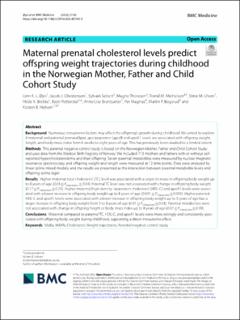| dc.contributor.author | Øyri, Linn K. L. | |
| dc.contributor.author | Christensen, Jacob J. | |
| dc.contributor.author | Sebert, Sylvain | |
| dc.contributor.author | Thoresen, Magne | |
| dc.contributor.author | Michelsen, Trond M. | |
| dc.contributor.author | Ulven, Stine M. | |
| dc.contributor.author | Brekke, Hilde K. | |
| dc.contributor.author | Retterstøl, Kjetil | |
| dc.contributor.author | Brantsæter, Anne Lise | |
| dc.contributor.author | Magnus, Per | |
| dc.contributor.author | Bogsrud, Martin P. | |
| dc.contributor.author | Holven, Kirsten B. | |
| dc.date.accessioned | 2023-05-09T13:42:38Z | |
| dc.date.available | 2023-05-09T13:42:38Z | |
| dc.date.created | 2023-04-20T13:31:10Z | |
| dc.date.issued | 2023 | |
| dc.identifier.citation | BMC Medicine. 2023, 1-11. | |
| dc.identifier.issn | 1741-7015 | |
| dc.identifier.uri | https://hdl.handle.net/11250/3067347 | |
| dc.description.abstract | Background Numerous intrauterine factors may affect the offspring’s growth during childhood. We aimed to explore if maternal and paternal prenatal lipid, apolipoprotein (apo)B and apoA1 levels are associated with offspring weight, length, and body mass index from 6 weeks to eight years of age. This has previously been studied to a limited extent. Methods This parental negative control study is based on the Norwegian Mother, Father and Child Cohort Study and uses data from the Medical Birth Registry of Norway. We included 713 mothers and fathers with or without self-reported hypercholesterolemia and their offspring. Seven parental metabolites were measured by nuclear magnetic resonance spectroscopy, and offspring weight and length were measured at 12 time points. Data were analyzed by linear spline mixed models, and the results are presented as the interaction between parental metabolite levels and offspring spline (age). Results Higher maternal total cholesterol (TC) level was associated with a larger increase in offspring body weight up to 8 years of age (0.03 ≤ Pinteraction ≤ 0.04). Paternal TC level was not associated with change in offspring body weight (0.17 ≤ Pinteraction ≤ 0.25). Higher maternal high-density lipoprotein cholesterol (HDL-C) and apoA1 levels were associated with a lower increase in offspring body weight up to 8 years of age (0.001 ≤ Pinteraction ≤ 0.005). Higher paternal HDL-C and apoA1 levels were associated with a lower increase in offspring body weight up to 5 years of age but a larger increase in offspring body weight from 5 to 8 years of age (0.01 ≤ Pinteraction ≤ 0.03). Parental metabolites were not associated with change in offspring height or body mass index up to 8 years of age (0.07 ≤ Pinteraction ≤ 0.99). Conclusions Maternal compared to paternal TC, HDL-C, and apoA1 levels were more strongly and consistently associated with offspring body weight during childhood, supporting a direct intrauterine effect. | |
| dc.description.abstract | Maternal prenatal cholesterol levels predict offspring weight trajectories during childhood in the Norwegian Mother, Father and Child Cohort Study | |
| dc.language.iso | eng | |
| dc.title | Maternal prenatal cholesterol levels predict offspring weight trajectories during childhood in the Norwegian Mother, Father and Child Cohort Study | |
| dc.title.alternative | Maternal prenatal cholesterol levels predict offspring weight trajectories during childhood in the Norwegian Mother, Father and Child Cohort Study | |
| dc.type | Peer reviewed | |
| dc.type | Journal article | |
| dc.description.version | publishedVersion | |
| dc.source.pagenumber | 1-11 | |
| dc.source.journal | BMC Medicine | |
| dc.identifier.doi | 10.1186/s12916-023-02742-9 | |
| dc.identifier.cristin | 2142175 | |
| dc.relation.project | EU – Horisont Europa (EC/HEU): 874739 | |
| cristin.ispublished | true | |
| cristin.fulltext | original | |
| cristin.qualitycode | 2 | |
